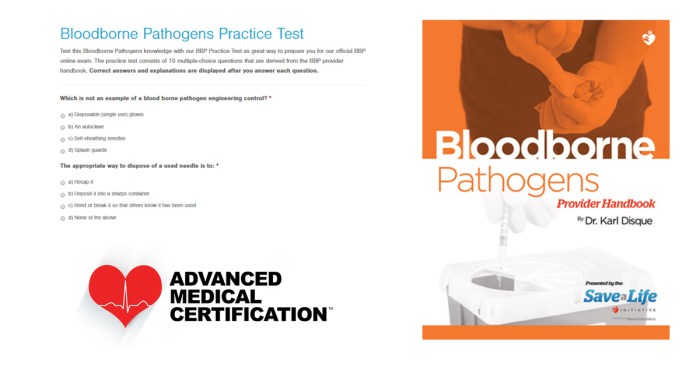Blood borne pathogens quiz answers are essential for healthcare professionals and anyone who may come into contact with blood or other potentially infectious materials. Understanding the risks associated with blood borne pathogens and implementing appropriate precautions is crucial for protecting both patients and healthcare workers.
This comprehensive guide provides blood borne pathogens quiz answers to common questions, covering topics such as types of pathogens, transmission methods, universal precautions, personal protective equipment, and exposure control plans.
By delving into the nuances of blood borne pathogens, this guide empowers individuals with the knowledge and tools necessary to navigate the complexities of infection control. Through a combination of clear explanations, practical examples, and engaging discussions, this guide aims to enhance understanding and promote best practices in preventing blood borne pathogen exposure.
Blood Borne Pathogens
Blood borne pathogens are microorganisms that can cause disease when they enter the bloodstream. They can be transmitted through contact with infected blood or other bodily fluids, such as saliva, semen, vaginal secretions, and cerebrospinal fluid.
It is important to understand blood borne pathogens because they can cause serious illness and even death. Some of the most common blood borne pathogens include HIV, hepatitis B virus (HBV), and hepatitis C virus (HCV).
Not following blood borne pathogens guidelines can have serious consequences. Healthcare workers who are exposed to blood borne pathogens may become infected and develop serious illnesses. Patients who are exposed to blood borne pathogens may also become infected and develop serious illnesses.
Types of Blood Borne Pathogens
There are many different types of blood borne pathogens. Some of the most common include:
- HIV
- HBV
- HCV
- Syphilis
- Gonorrhea
- Chlamydia
These pathogens can be transmitted through contact with infected blood or other bodily fluids. The transmission methods vary depending on the pathogen.
For example, HIV is transmitted through contact with infected blood, semen, vaginal secretions, or breast milk. HBV is transmitted through contact with infected blood or saliva. HCV is transmitted through contact with infected blood.
The symptoms of blood borne pathogens vary depending on the pathogen. Some of the most common symptoms include:
- Fever
- Chills
- Muscle aches
- Fatigue
- Nausea
- Vomiting
- Diarrhea
- Rash
Universal Precautions

Universal precautions are a set of infection control practices that are used to prevent the transmission of blood borne pathogens. These practices are based on the principle that all blood and body fluids are potentially infectious.
The steps involved in universal precautions include:
- Wearing gloves, gowns, and masks when handling blood or body fluids
- Washing hands frequently with soap and water
- Cleaning and disinfecting surfaces that have been contaminated with blood or body fluids
- Properly disposing of sharps
It is important to follow universal precautions to prevent the transmission of blood borne pathogens. Healthcare workers who do not follow universal precautions may become infected and develop serious illnesses. Patients who are exposed to blood borne pathogens may also become infected and develop serious illnesses.
Personal Protective Equipment (PPE)
Personal protective equipment (PPE) is a type of clothing or equipment that is worn to protect the wearer from exposure to blood borne pathogens. PPE includes gloves, gowns, masks, and eye protection.
The type of PPE that is required will vary depending on the task being performed. For example, healthcare workers who are performing a procedure that involves a high risk of exposure to blood borne pathogens will need to wear more PPE than healthcare workers who are performing a procedure that involves a low risk of exposure to blood borne pathogens.
It is important to use PPE properly to prevent the transmission of blood borne pathogens. Healthcare workers who do not use PPE properly may become infected and develop serious illnesses. Patients who are exposed to blood borne pathogens may also become infected and develop serious illnesses.
Exposure Control Plan
An exposure control plan is a written plan that describes the procedures that will be used to prevent the transmission of blood borne pathogens. The exposure control plan should be developed by a qualified healthcare professional, such as an infection control nurse or a physician.
The exposure control plan should include the following components:
- A description of the tasks that are performed in the workplace that involve exposure to blood borne pathogens
- A list of the PPE that is required for each task
- A description of the procedures that will be used to clean and disinfect surfaces that have been contaminated with blood or body fluids
- A description of the procedures that will be used to properly dispose of sharps
- A description of the procedures that will be used to report exposures to blood borne pathogens
It is important to have an exposure control plan in place to prevent the transmission of blood borne pathogens. Healthcare workers who do not have an exposure control plan in place may become infected and develop serious illnesses. Patients who are exposed to blood borne pathogens may also become infected and develop serious illnesses.
Training and Education

Training and education on blood borne pathogens is essential for healthcare workers. This training should cover the following topics:
- The risks of exposure to blood borne pathogens
- The methods of transmission of blood borne pathogens
- The symptoms of blood borne pathogens
- The universal precautions that must be followed to prevent the transmission of blood borne pathogens
- The PPE that is required for different tasks
- The procedures that must be followed to clean and disinfect surfaces that have been contaminated with blood or body fluids
- The procedures that must be followed to properly dispose of sharps
- The procedures that must be followed to report exposures to blood borne pathogens
Healthcare workers who are not trained on blood borne pathogens may become infected and develop serious illnesses. Patients who are exposed to blood borne pathogens may also become infected and develop serious illnesses.
Recordkeeping and Reporting: Blood Borne Pathogens Quiz Answers
It is important to keep records of all exposures to blood borne pathogens. These records should include the following information:
- The date and time of the exposure
- The source of the exposure
- The type of exposure
- The name of the healthcare worker who was exposed
These records should be kept for at least 30 years. They may be used to track exposures to blood borne pathogens and to identify trends.
It is also important to report exposures to blood borne pathogens to the appropriate authorities. This may include the local health department or the Occupational Safety and Health Administration (OSHA).
Commonly Asked Questions
What are blood borne pathogens?
Blood borne pathogens are microorganisms that can be transmitted through contact with infected blood or other body fluids.
What are the common types of blood borne pathogens?
Common blood borne pathogens include HIV, hepatitis B, and hepatitis C.
How are blood borne pathogens transmitted?
Blood borne pathogens can be transmitted through contact with infected blood, semen, vaginal fluids, or breast milk.
What are universal precautions?
Universal precautions are a set of infection control practices that are used to prevent the transmission of blood borne pathogens.
Why is it important to follow universal precautions?
Following universal precautions helps to protect healthcare workers and patients from exposure to blood borne pathogens.